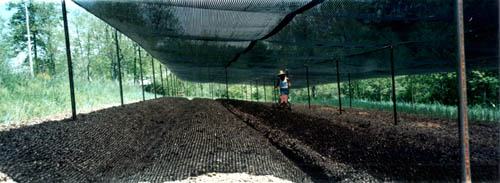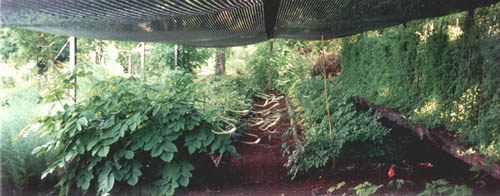
|
|
||
Forest Floor: Simulating a Forest in a Well-worn Pasture
by Lavinia McKinney
At Elixir Farm embarked we on an experiment to create a one-fourth acre artificial shade garden to learn the intimacies of growing shade-loving medicinals in close proximity.

The Ozarks is an eroded plateau that remained unglaciated during the last interglacial period. We live in a river valley in which the eroded sand from the forested plateaus has formed first and second bottoms. In the second bottom there is a 8 foot layer of very smooth old sand that does not have much organic matter and insignificant trace minerals after, at least, a known 50 years as an animal grazed pasture. Underlying this sand layer is a red clay and chert-like rock substrate. The pH of this area is very acidic; about 4-5pH.
The following course has been taken: The plot is 50' x 250'or 12500 sq. feet.
- Spring 98: We used a small bulldozer to smooth the 15% slope, filling in the erosion pathways and creating a berm above and below the plot.
- The soil was then disked, tilled and worked to loosen the top layers. A 30 hp tractor was used.
- Followed by spraying the bare soil with Barrel Compost and BD 500.
- Over the next several weeks we added approximately six inches of 50 year old mixed hard/softwood sawdust over the entire plot. Approximately 120 cubic yards of material.
- We worked this into the almost pure sand over the summer. Using a rotating tiller and a drag behind chisel type digger that penetrated the sand to a 12 to 18 inch depth working only when the moisture content allowed significant penetration.
- We sprayed with barrel compost and 500 again.
We planted a buckwheat and millet cover crop that did not catch. The sawdust was too loose and the seed went too deep. We planted again after rolling with a field roller. It was to dry to start the seed, and of course, too acidic. But some seed did sprout and the resulting plants were off color running to the red side of the spectrum. By this time the sawdust was beginning to mix with the sand and some decomposition was beginning to happen. When we dug into the plot we saw that the "soil depth" was about 18 inches at best and decided that a deeper breaking of the compacted sand layer was needed. When you dig in the forest soil it is sandy but filled with humus and litter for many feet because of the annual leaf fall. On the ridgetops the forest floor is only three feet deep before hitting a hard rocky limestone substrate. The hollers and the bottoms have a deeper layer of sandy loam.
We then broke the deep layer of compaction with a 3 ft chisel using a 75 horsepower tractor. The ground was cut downhill on the first pass and across the slope the second pass. This was followed by some light discing with the light tractor, rolled then planted with winter rye and hairy vetch. Very little germination occurred. The rainfall was insignificant.
Another light discing, then a planting of winter wheat alone, followed by rolling, produced the first significant germination. Though sparse, the color of the foliage was correct and the plants continued to grow through December. By this time, seven months after the application of sawdust, the material was mixed thoroughly with the sand. You could stick your hand into the soil 10 inches.
In late December 1998 we began to harvest the litter from the forest. The ground was frozen and we put approximately 6-8 inches of ground leaves over the top of the soil. This leaf harvest is done by raking the floor down into some of the decayed litter and loading it into trucks. The litter/leaf mix is then ground with a haymulcher and blown onto the ground. There are sticks and acorns and new leaves and decayed material all being mixed together. I imagine that the necessary ingredients that will innoculate the semisterile soil mix that we have created are present in this material.
Then we rototilled this into the top foot of soil to allow the blend to perk over the winter. We are currently in the process of setting the pipe and cable infrastructure to carry the shade. Next is to install irrigation and then begin to make the beds.
The four foot beds will be created with a walking tractor. The paths will be layered with sawdust. The edges of the beds will be fortified with some recycled material. When the beds are established we will give them a light application of BD compost and the sprays. The beds will be covered by weed mat and planted with golden seal, black cohosh bupleurum, atractylodes, ginseng, and bloodroot. A final mulch of leaves will be applied and maintained.

The question of why go to this much trouble to make a forest in the pasture? For the understanding? Why not go into the forest where all is already there? Why have controlled, artificial plots?
The idea is to take the experiment to its completion by planting dogwood, redbud seedlings and overstory trees. by the time the shade cloth is finished there will be enough shade for the plot to be an understory. The time gained by establishing plantings that may take up to seven years to harvest could justify the labor and energy intensive development. The accessibility of the plot to the home and humans will assure that the observation and care of the plantings is easy. This is a healing garden for the residents of the next century.

Hosted by Institute for Global Communications